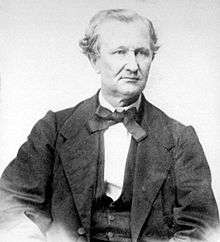Henry Meiggs

Henry Meiggs (July 7, 1811 – September 30, 1877), was a promoter/entrepreneur and railroad builder born in Catskill, New York.[1]
Business career
Lumber
Meiggs came to New York City in 1835 and began a lumber business that was ruined by the Panic of 1837. He restarted his business in Brooklyn, but again met with failure. Finding success in sending lumber to the Pacific Coast, he relocated to San Francisco during the peak of the California Gold Rush on the cargo ship Albany laden with lumber, which he sold there for twenty times its cost.
Real estate
When Meiggs arrived in San Francisco in 1849, he, like many others, got into real estate speculation. In Meiggs' case, he promoted the possibility of piers along the north shore area, on the grounds that it was closer to the Golden Gate than the usual harbor, located just south of Broadway Street on the shore of what is today downtown San Francisco. Today, the site of Meiggs' Wharf, in its day a marvel extending two thousand feet into the Bay, is occupied by part of Fisherman's Wharf, Pier 39, and Pier 45.[2] To that end, he built warehouses, streets and piers in the area, and constructed sawmills and schooners.
Meiggs became extended financially in trying to do this. In order to make ends meet, he illicitly obtained a book full of warrants on the Street Fund (which had little money in it), which the city's controller and mayor had fallen into the habit of signing by the book in advance. Meiggs forged the remaining information and raised money.
Railroads
Before his fraud was discovered, Meiggs left San Francisco on October 6, 1854, in the brig American, heading for South America. According to him, he landed with only $8,000 (his fraud raised, by some accounts, half a million), lost it immediately, and had to pawn his watch.[3]
Meiggs became a successful railroad builder, building the second railroad in Chile, between Santiago and Valparaíso. He also built many railroads in Peru, and died in 1877 in Lima, Peru while constructing a railroad in Costa Rica which was completed by his nephew, Minor C. Keith. He is said to have been the virtual dictator of Peru by that time, known as "Don Enrique", with interests ranging from silver mines to cleaning up the city of Lima by building a seven-mile-long park.[4]
While his Peruvian contracts were wildly profitable, by 1876, his financial situation had begun to disintegrate. He found it more difficult to obtain credit. His 1877 death only worsened the economic chaos in Peru. He was buried at Presbítero Maestro cemetery in downtown Lima.
Legacy
Meiggs is said to have paid back every cent he obtained by the warrant fraud, and his other debts, amounting to as much as a million dollars, refusing only to pay back speculators who obtained the warrants at deep discounts. In preparation for his never-to-occur return to San Francisco, he got the State Legislature to pass a bill making it illegal to try him for offenses occurring before 1855. The bill was vetoed by the governor.
In 1977, one hundred years after Meiggs' death, Judge Harry W. Low of the California Superior Court, in San Francisco, granted a motion to quash the indictment against Meiggs stemming from the fraud, on the grounds that Meiggs had rehabilitated himself, and had gone to a Higher Court. This marked the conclusion of a lengthy campaign by Meiggs' supporters to clear him.
An EC2 type Liberty Ship would also carry his name. The USS Henry Meiggs, hull 2788 was launched in April 17, 1944. She was scrapped in 1971.
Meiggs is credited with founding the town of Meiggsville, later renamed Mendocino.
Notes and references
| Wikimedia Commons has media related to Henry Meiggs. |
- ↑ "Henry Meiggs (#526)". Meigs.org. 1977-07-19. Retrieved 2013-08-16.
- ↑ "World Seaports in the 1800s: The Maritime Heritage Project with News of Captains, Ships and Passengers". Maritimeheritage.org. Retrieved 2013-08-16.
- ↑ "Henry Meiggs of Meiggs' Wharf". Sfmuseum.org. 1925-12-05. Retrieved 2013-08-16.
- ↑
- Elisabeth P Myers, South America's Yankee Genius, Henry Meiggs. New York, Messner, 1969.
- Watt Stewart, Henry Meiggs, Yankee Pizarro, Durham, N.C., Duke University Press, 1946.
Television
- 2013 Monumental Mysteries, a Travel Channel program, featured a segment on Meiggs centering on the financing of the construction of Fisherman's Wharf. He was portrayed by American actor Paul Meltzer.